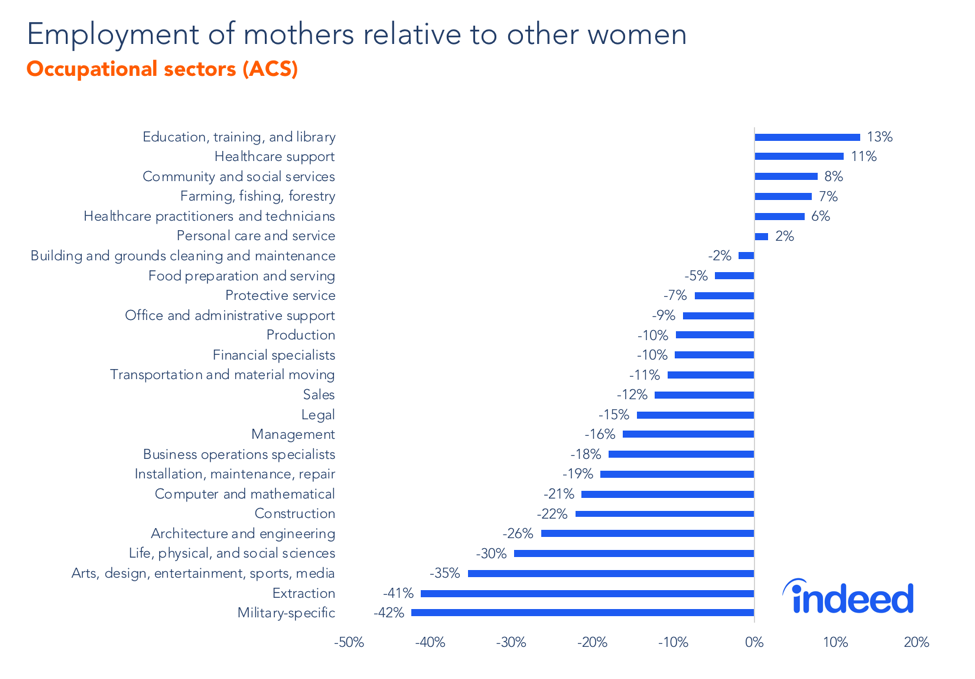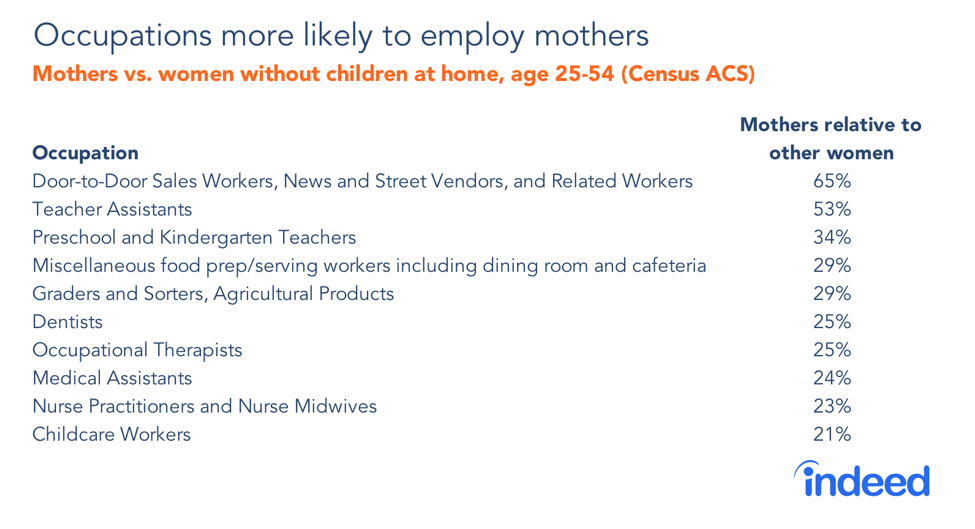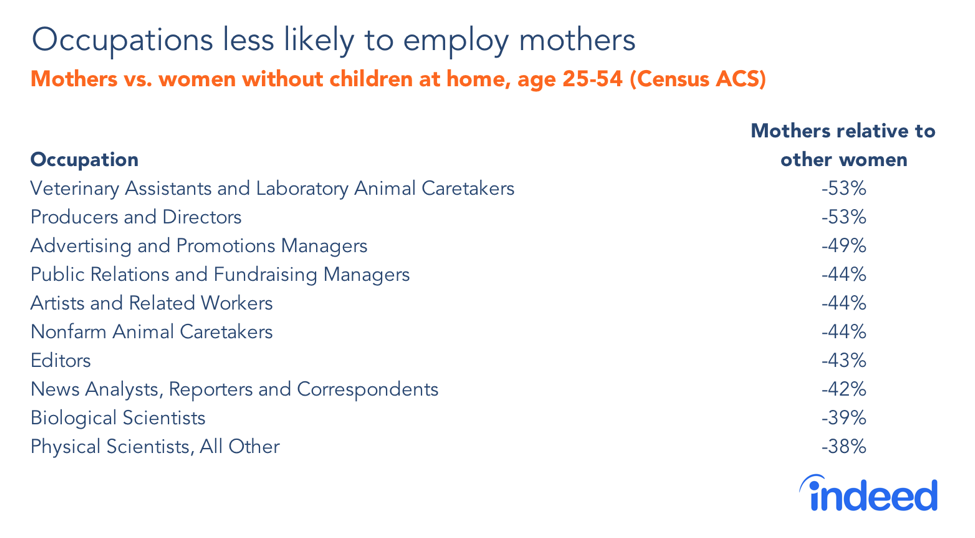In honor of Mother’s Day, the Indeed Hiring Lab is taking a look at moms in the labor force. Of course, motherhood itself can be a full-time job. Yet most working-age women with children are also employed in the labor market. Overall, 69% of women between 25 and 54—prime working age—who have kids under 18 at home are employed. That’s not all that much less than the 75% employed share of prime-working-age women without kids under 18 at home. Even among moms with kids under six, 63% are employed—and three-quarters of them work full-time. To look at it another way, one-sixth of all employed workers are mothers with kids at home.
Nevertheless, these similar employment levels between mothers and women without children hide important differences. Mothers are underrepresented in some occupations, particularly in journalism, science and the arts. In other occupations, including several in education and healthcare, mothers are more likely to be employed than women without children.
We used data from the Census American Community Survey to compare the occupations of mothers with those of other women. Specifically, we looked at all prime-working-age women and compared those with and those without children under 18 at home. To focus on the relationship between motherhood and occupation, we made some statistical adjustments to make sure the two groups of women were demographically similar. (See methodology note for details).
Mothers are more likely to work in education, but less likely in journalism and the arts
In most sectors, mothers are underrepresented relative to other women because, as we noted, mothers are less likely to be employed overall. Adjusted for demographic differences, the sector in which employment of mothers is highest relative to other women is education, training and library occupations. Moms are 13% more likely than women without kids at home to work in this sector. Stated differently, after adjusting for other demographic differences, 7.2% of all prime-age women with kids under 18 at home are employed in this sector compared with 6.4% of prime-age women without kids at home. Mothers are also 11% more likely to work in healthcare support and 6% more likely to be healthcare practitioners and technicians than other women with similar demographics. (Sectors are defined here.)
The gap is biggest in extraction (mining and similar occupations) and military-specific occupations. Mothers are more than 40% less likely to work in those areas than women without kids. Employment is also notably lower for mothers in the creative sector (arts, design, entertainment, sports, media) and the sciences.

Within these broad sectors, several specific occupations stand out. Mothers are 65% more likely to be door-to-door salespeople or vendors than other women with similar demographics. Several of the occupations with higher employment of mothers involve working with children. Mothers are 53% more likely to be teacher assistants, 34% more likely to be preschool and kindergarten teachers, and 21% more likely to be childcare workers. Several health-related occupations also rank among the top ten, including dentists, occupational therapists, medical assistants, and nurse practitioners.

Several occupations stand out for lower employment of mothers compared with other demographically similar women. Journalism, for one. Editors and news analysts, reporters and correspondents are on the most-underrepresented list. Moms are also underrepresented among announcers, camera operators, and sound technicians.
Mothers are also much less likely than other women to work in the arts. Producers and directors, artists, actors and dancers are among the most underrepresented occupations for moms. Other occupations where mothers are most underrepresented include jobs working with animals, like veterinary assistants and nonfarm animal caretakers, as well as animal trainers and animal control workers.

Many possibilities why some jobs employ more or fewer mothers
Time for the obvious question: Why are mothers more or less likely to be employed in many occupations relative to other women with similar demographics? Unfortunately, these rankings can’t tell us whether the differences reflect workplace cultures, parental-leave, and benefits policies, individual career choices or other factors. For instance, it could be that the women who become mothers were already drawn to teaching or dentistry. Alternatively, these occupations may be more accommodating to working mothers.
One pattern does emerge: In occupations where employment of mothers is high relative to other women, women in general account for a higher share of workers than men. In occupations that are at least 80% female, on average there is no difference in the employment of mothers and other women with similar demographics. But in occupations that are at least 80% male, mothers are 19% less likely to be employed than other women with similar demographics. It may be that occupations where women dominate are more likely to have cultures, policies, and benefits that support working moms.
As we’ve stressed, this analysis doesn’t explain why some occupations employ fewer mothers than other demographically similar women. The reasons might be cause for concern in some occupations, but benign in others. Still, workplaces and industries where mothers are underrepresented–like the arts, journalism, sciences, and animal-related work—should examine why these gaps exist and whether their policies or culture might be made more supportive of working mothers.
Methodology
This analysis is based on the American Community Survey Public Use Microdata Sample, accessed via IPUMS, for 2012-2016.
Throughout this post, “mothers” means prime-working-age women with children under 18 at home. Demographics are correlated with both motherhood and with employment and occupation. To adjust for demographic differences between mothers and women without children, we calculated the occupational distribution for both groups for every combination of six five-year age bands, five educational categories, six marital-status categories, and five racial/ethnic categories. Then, we calculated the weighted average of the occupational distribution for each group across all demographic combinations, using the same weights for both groups. The weights are the shares of each demographic combination within the entire population of women from 25 to 54, including the unemployed and those not in the labor force. We confirmed our results using logit regressions for each occupation (dependent variable: respondent employed in that occupation) on saturated dummies for all demographic variables and a dummy for having children at home, the variable of interest. The coefficient on the children-at-home dummy was statistically significant for all occupations shown in this post’s tables. Only occupations with at least 1,000 employed prime-working-age women in the five-year ACS sample are shown in the tables.
The employment and full-time/part-time figures at the start of the blog post are from the Current Population Survey 2017 Annual Social and Economic Supplement, also accessed via IPUMS. Those numbers are not adjusted for demographic differences.






